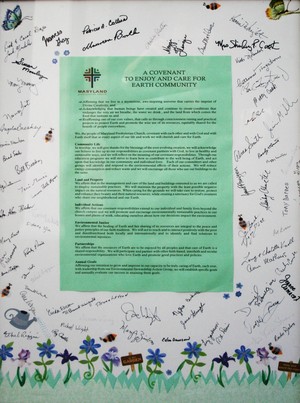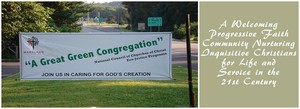Celebrating 5th Year PCUSA Certified Earth Care Congregations!

Maryland Presbyterian Church, situated in several acres of wooded real estate in Towson, MD, has been working on caring for God’s creation for over a decade. Among the first few churches that started as a pilot project of PCUSA Earth Care Congregations, church members at Maryland Presbyterian Church long have been conscious of the importance of conservation and initially began by incorporating “making peace with the earth” into their peacemaking efforts as a congregation.
Bill Breakey, a member of the Environmental Stewardship Action Group at MPC, explains that in 2002 the congregation did a study and visioning process over a period of months, “to look at where we are situated and what our calling is, in this era, in this particular place.” In addition to peacemaking, and attending to the poor and needy, this congregation also felt called to deeper care for the earth.
“It started out with us very rapidly coming to realize that saving the earth is a pretty big undertaking and what we should do is to start close to home, and we should look at our own property. We decided, ‘Let’s start here. What do we need to do to make our own little corner better, from an ecological standpoint?’ Eradicating invasive plants from our woods, working on projects of that sort. Then we made use of the NWF Backyard Wildlife Habitat standard- had to provide water for birds, planted some trees and shrubs to provide food,” says Breakey.
From there, Maryland Presbyterian Church got into storm water management (including installing a rain garden) and energy efficiency (including improved efficiency lights). Then about six years ago, they created a covenant on caring for God’s creation. Breakey comments, “We got people from all sectors of the church to share in writing this document, which we then presented to the congregation for comment, and then formerly adopted by session, and then on Earth day (as part of an Earth Day Sunday worship service) it was on easel at front of sanctuary and everybody present, just about, came forward and signed it.”

Pat Cornman, the current Chair of the Environmental Stewardship Action Group, joined Maryland Presbyterian Church more recently, not long after she visited the first time. She was impressed that the congregation was not only located on beautiful property but took seriously their care for the world around them. Cornman, who works to review reforestation plans for Baltimore County and the Mid-Atlantic, shares, ““I have been with the church for about 4 years. I was brought by a friend of mine, a colleague at work, and almost immediately when I came into the church, I could see a forest behind the church, and everyone at the church was kind and welcoming and very aware of the importance of creation. Branch Warfield, [one of the original members of these efforts who still undergirds the program] took me under his wing, as we did the recertification [for Earth Care Congregations]. I could see there was a lot of value to this process. It focuses us. Here was something to consider, not just to get points to get recertified, but to focus.”
Breakey agrees that, while their church would undoubtedly be committed to God’s creation regardless, having the PCUSA Earth Care Congregation certification focuses them, “having the audit gives us a chance on an annual basis to assess where are we and where are our strengths and where are our weaknesses, where are we doing well and where we have room to grow. This is a tremendously valuable aspect of the Earth Care Congregation program, that it asks each year that you do more. You cannot rest on your laurels.”
Cornman and Breakey were both involved in a recent hosting of 40 children from another downtown church in their presbytery, whose pastor just this year had an Earth Day Sunday at his congregation after hearing a presentation from the presbytery’s Creation Care Group at a presbytery meeting. The 40 children that came to MPC primarily live in a part of town where streets were not well cared for and recycling doesn’t enter into consciousness. Cornman took a group into the woods while other groups learned about bee keeping and walking the labyrinth. She shares, “we had children turn over logs and finding mushrooms, and how nature recycles everything—the mushrooms are the clean-up squads of the woods.” All the children, at the end, participated in a recycling relay. The day was a lot of fun for everyone and a great success in teaching the “value of not throwing bottles and paper in the gutter, and even the value of maybe picking up someone else’s trash and putting it where it should go.”
Another form of outreach for this church is through taking public policy positions related to local and national environmental legislation, such as developing wind farmsoff the coast of Maryland. Also, in response to a talk by a Rwandan pastor, the church decided to raise money and send it to a this pastor’s parish back in Rwanda, so that those church members could plant fruit trees and enrich their soil in order to grow food on the volcanic soil in that war-torn region.
Rev. Mary Gaut, pastor of Maryland Presbyterian Church, is encouraging the church in their continued efforts as she has been accepted as a GreenFaith Fellow this past year. In this program, Rev. Gaut is learning and growing with an interfaith community of other “Fellows” that bring ecological and theological lessons back home to their own congregations.
Whether it’s the pastor or the Environmenal Stewardship Action Group or other groups in the church, this congregation keeps looking for new ways to engage their sense of stewardship. They want to continue growing and they do it through channels such as encouraging other churches in their neighborhood and participating in the . “Covenantal Partners Program” of Interfaith Partners of the Chesapeake. Cornman comments, “That’s the good thing about our church, we are always thinking how we might make outreach better.”
While wanting to be inspirational, they also want to call themselves and others to action. “It’s not out of our hands, it’s not out of our control, but we do not have any time to waste,” Cornman says about climate change and other environmental concerns. Maryland Presbyterian Church, in its long history of caring for God’s creation in myriad ways, is indeed showing that the church has a role to play in the wider world and is called to spread good news, to transform our own lives, and to act for a hopeful future for all God’s earth.

* * *
There are currently 140 certified PCUSA Earth Care Congregations. For the initial year of certification, each church fills out a congregational audit, gains session approval of an “Earth Care pledge,” and has an earth care team of some sort. This first year of certification often means that a church has been working to integrate care for God’s creation into its ministry for a number of months or years prior to certifying. Each additional year of recertification requires the congregation to both continue and to grow their efforts at integrating creation care into the life of the church. Begun in 2010, this PCUSA certification program has 13 churches now entering their 5th year of certification.
The “5th year certified” churches are: Light Street Presbyterian Church (Baltimore, MD), Trinity Presbyterian Church (East Brunswick, NJ), Bardstown Road Presbyterian Church (Louisville, KY), Church of Reconciliation (Chapel Hill, NC), Montevallo Presbyterian Church (Montevallo, AL), St. Andrews Presbyterian Church (Tucker, GA), Second Presbyterian Church (Little Rock, AR), Maryland Presbyterian Church (Towson, MD), First Presbyterian Church of Howard County (Columbia, MD), North Como Presbyterian Church (Roseville, MN), First Presbyterian Church (Cottage Grove, OR), Swarthmore Presbyterian Church (Swarthmore, PA), St. Andrews Presbyterian Church (Kilmarnock, VA) and Frame Memorial Presbyterian Church (Stevens Point, WI).